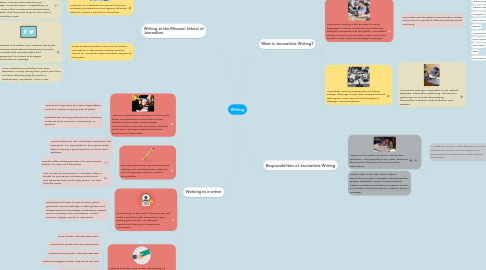
1. Working as a writer
1.1. Writers in journalism must have a well-honed sense of professional values that are the hallmark of journalism and strategic communication–honesty, accuracy, creativity and a sense of responsibility toward the beneficiary of their work.
1.1.1. Writers and reporters at a news organization serve the media company and its public.
1.1.2. Professionals writing publicity and marketing materials work to serve a corporation or product.
1.2. Strong writers have a good command of grammar, word precision, efficient use of language and are creative story-tellers.
1.2.1. Good writers are self-motivated, inquisitive and persistent. It is impossible to be a good writer without being a good reporter or information gatherer.
1.2.2. Poynter offers writing process and resources for writers. To view, click the arrow.
1.2.3. The Society of Professional Journalists offers a toolkit for journalists, including online tools and resources that could help writers. To view, click the arrow.
1.3. To find work in the field of writing, you will need a portfolio with examples of your writing gained from "on-the-job" experience from your courses and internships.
1.3.1. Employers will want to you to know good grammar, have knowledge of style guides and subject-specific knowledge of whatever subject you're covering, such as business, health, science, religion, sports or education.
1.4. Salaries of writers vary widely depending on the size, ownership and reach of an outlet. The highest salaries are at large media outlets.
1.4.1. Local media: $23,000-$50,000+
1.4.2. Metro-level media: $40,000-$100,000+
1.4.3. Trade/technical writer: $25,000-$80,000
1.4.4. National magazine writer: $55,000-$120,000
1.4.5. Columnist: $50,000-$150,000+
1.4.6. Online writer/blogger: $0-$75,000
1.4.7. Public relations/Advertising: $35,000-$200,000
2. Writing at the Missouri School of Journalism
2.1. Writing is an important component at every professional newsroom and agency affiliated with the Missouri School of Journalism.
2.1.1. Most MU writing courses will contain "writing", "reporting" or "news" as part of their name.
2.1.2. Students especially interested in journalistic writing may want to pursue an interest area in Magazine Writing, News Reporting or Strategic Communication: Copywriting. To view more of the courses and interest areas available, click the arrow to go to the School of Journalism's site.
2.2. Social media provides a new role for writers and editors in the media industry–and the School of Journalism helps students prepare for these jobs.
2.2.1. Facebook and Twitter have created new styles of writing–conversational writing and concise summaries that increase traffic and engagement to a news or strategic communication message.
2.2.2. Once students are admitted into their sequence, usually during their junior year, they can learn about writing for social in Participatory Journalism, Journ 4700.
3. What is Journalistic Writing?
3.1. Journalistic writing is the process of using language to inform, entertain, persuade and educate consumers and the public. Journalistic writing is used in print, audio, video and social media in both news and strategic messages.
3.1.1. Journalists and strategic communication writers may write in a variety of different environments including:
3.1.1.1. Breaking news articles
3.1.1.2. Photo cutlines
3.1.1.3. Listings of information
3.1.1.4. Advertising copy
3.1.1.5. Television news scripts
3.1.1.6. Investigations
3.1.1.7. Radio news scripts
3.1.1.8. Editorials
3.1.1.9. Magazine articles
3.1.1.10. Opinion pieces
3.1.1.11. Press releases
3.1.1.12. Books
3.1.1.13. Social media posts
3.2. Journalistic writing is generally non-fiction writing, although it may often employ fictional techniques in the case of advertising and strategic communications.
3.2.1. Journalistic writing is impossible to do without adequate information gathering. Information gathering can include interviewing, observation, research, data collection and analysis.
4. Responsibilities of Journalistic Writing
4.1. Writers in the media are prime information gatherers. They typically must make decisions about what information becomes public information.
4.1.1. In addition, writers make decisions on how that content should be communicated and prioritized for audiences to meet industry standards.
